Rosewood History
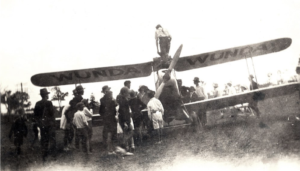
“WUNDA” Moth aeroplane at Rosewood – November 1929
AIRCRAFT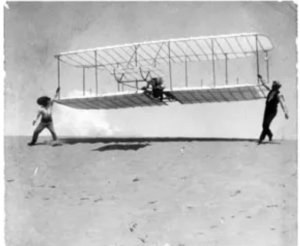
The first flight – Wilbur and Orville Wright spent four years of research and development to create the first successful powered airplane (sic), the 1903 Wright Flyer. It first flew at Kitty Hawk, North Carolina, on 17th December 1903 with Orville at the controls.
————————————————————————————————
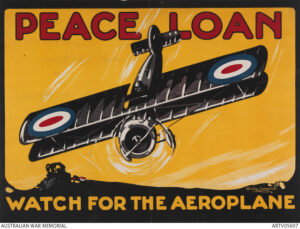
On Tuesday 9th September 1919, Captain Francis Ryan Smith M.C. D.F.C. who was piloting a plane for the Peace Loan Campaign left Brisbane and flew over North Ipswich en route to Toowoomba (his birthplace). He was flying at an altitude of 3,000 ft and the residents didn’t get a good view. The residents of Rosewood had been informed about the flight and had kept a keen vigil for the approach of the plane. At about 11.05 a.m. a dark speck was seen in the eastern sky, which gradually became more into focus. As it passed over the town the buzz of the engines was distinctly heard. The plane was visible for about half-an-hour before it went out of sight. The flight was possibly the first time residents of Rosewood saw an aeroplane.
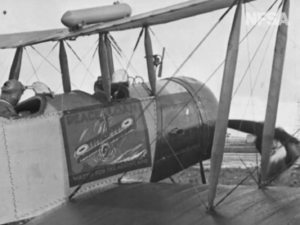
————————————————————————————————
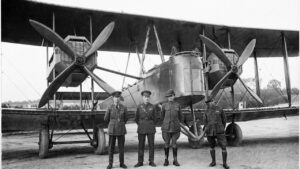 Sir Ross Smith and his brother Sir Keith Smith piloted a Vickers Vimy on the first flight from London, England to Australia. They landed at Darwin 10th December 1919.
Sir Ross Smith and his brother Sir Keith Smith piloted a Vickers Vimy on the first flight from London, England to Australia. They landed at Darwin 10th December 1919.
They resumed their flight to Adelaide but a hawk flew into the propellor 20 miles out from their second stopping place, Anthony’s Lagoon, a cattle station on the Barkly Tableland in the Northern Territory. The plane appeared to suffer only slight bruising, but once in flight again it burst and one of the blades split completely. The pilots made a forced landing and were reported lost for three days.
A Government contractor appeared on the scene, and they borrowed some iron strips, nails and glue from the police station at Anthony’s Lagoon. With these items makeshift repairs were made to the propellor.
The next stop was at A. J. Cotton’s station, Brunette Downs, then on to Charleville.
On Christmas morning they left Charleville for Bourke and, almost immediately, a connecting rod broke. They stayed at Charleville for a month while the engine was sent to the railway workshops at Ipswich where a new connecting rod and propellor were made at a cost of £459.
The Minister of Railways asked that when the propellor had an outlived its usefulness, it be returned and kept at the Queensland Museum.
At the Empire Exhibition in Brisbane in 1924 there were exhibits from all over Queensland. The aeroplane propeller made at the Ipswich Railway Workshops was one of the exhibits.
————————————————————————————————
In May 1920, the Perdriau Co.’s BE2E biplane fitted with an 80 hp Raf engine, left Sydney on a promotional flight to Brisbane. On its last stage of its journey it left Toowoomba at 1p.m. and passed over Rosewood about 1.15 p.m. It was plainly visible to residents of Rosewood and was travelling at a fast rate. The buzz of the engine was distinctly heard.
Ipswich residents saw the plane coming at a height of about 3,000 feet.The machine passed directly over the railway workshops and as it did so it dipped (3 times) as a salute to the experts in the shops who had performed the task of repairing Sir Ross Smith’s aeroplane.
As it approached the centre of the city it made a graceful spiral dive from a height of 3,500 ft to 1,500 ft and circled two or three times over the town centre and then made off in the direction of Lytton, where it landed at 2.05 o’clock. A number of tiny kite balloons (parachutes) were dropped, each of which contained an order on a retail store for a pair of tennis shoes manufactured by the Perdriau Rubber Company. Lieut. J. H. Butler was in charge of the machine.
————————————————————————————————
Qantas, Australia’s first airline, was established on 16th November 1920 at Winton by four First World War veterans.
————————————————————————————————
On 1st January 1927, the Brisbane Courier’s fast delivery service by aeroplane and speedy motor cars began. It created a profound impression, and numerous letters of congratulations were received by the management warmly praising the daily morning delivery of “Couriers” in distant centres.
That morning the aeroplane “The Courier” left the aerodrome at Eagle Farm at 3.18 a.m. and delivered Couriers at Toowoomba at 6.13 a.m. The weather conditions were unpromising and gave the pilot some trouble. After passing Gatton, the plane ran into heavy mist which completely obscured land marks. However, the pilot took the plane well above the clouds and finally picked up Helidon, having gone considerably south from a direct course. The journey was accomplished in just under the hour despite the set backs.
On the return trip the plane was flown low down over the range and when Rosewood was passed, the weather conditions were quite good.
The specially rapid motor car service to the Tweed Heads and intervening townships was a success and residents along that route were supplied with their copies long before breakfast time.
The service to Wynnum Manly and Lota was also a success and holiday makers and residents of the seaside resorts thoroughly appreciated being able to read their ‘Couriers” at the same time that citizens of Brisbane were reading theirs.
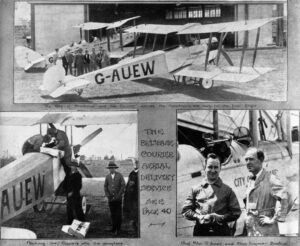
————————————————————————————————
On Thursday 21st July 1927, at about 5.30 p.m., some excitement was caused in Rosewood when an aeroplane en route from Longreach to Brisbane landed on a level area in Stan Forsyth’s paddock, close to the Toowoomba Road and close to the Bremer. People had been watching the plane and noticed its path was irregular and thought it was in trouble. After circling for a while the engine stopped and it appeared to dive, but it landed safely apart from a slight bump on the wing which struck a log on the ground. Sergeant Tighe and Mr. W. J. Campbell rushed to the scene and found out that the pilot had decided to descend because it was getting dark and his petrol tank was giving him trouble. He decided to look for flat country to land. In a very short time over fifty cars and a couple of hundred people surrounded the plane. The pilot caught a train to Brisbane that night but returned the next morning to find his aircraft was still attracting many visitors. After being delayed due to wet weather, the pilot left later in the day.
————————————————————————————————
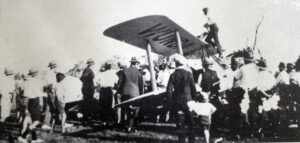
Messrs. Bishop and O’Sullivan (fire insurance adjusters from Brisbane) applied for permission to use the Rosewood recreation reserve for conducting aeroplane flights with the “WUNDA” Moth aeroplane on Saturday 16th and Monday 18th November 1929. Permission was granted at a charge of £1/1/- per day. The pilots were T. R. Young and H. A. Davies, of Sky Travel (Aust.) Ltd. The flights were popular and a great many people viewed the scene from aloft, which was described as wonderful, the beautiful agricultural district being pictured in a pleasing panorama. The public were thrilled by the stunt flying of Pilot Young.
WUNDA paid a second visit to Rosewood in July 1930 when joy flights were held on the weekend. The manoeuvres of the aeroplane and stunts performed by Pilot Young added greatly to the pleasures of Show Week.
————————————————————————————————
The first Royal Flying Doctor Service took its first flight from Cloncurry on 17th May 1928.
Sir Charles Kingsford Smith landed in Brisbane on 9th June 1928 after completing the first trans-Pacific flight a three-leg journey from California to Brisbane via Hawaii and Fiji.
————————————————————————————————
Amy Johnson achieved worldwide recognition when, in 1930, she became the first woman to fly solo from England to Australia. She left Croydon airport in Surrey, England on 5th May and landed at Darwin on 24th May.
————————————————————————————————
Queensland Times, Friday 8th August 1930, page 6
THESE NOISY AEROPLANES. Aeroplanes have become so common in Rosewood that they are creating a nuisance. This is the opinion of at least one resident of Rosewood who petitioned the council yesterday to restrain airmen from flying over the town on Sundays. On a recent Sunday, the objector stated, a plane flew over the town and rudely disturbed the peaceful calm of this charming rural centre. Various remedies for the intrusion were suggested by councillors. One member even advocated an appeal to the Air Ministry.
————————————————————————————————
On 30th July 1931, Mr and Mrs A. Wilkins had a surprise party at their home at Ebenezer. Aeroplane rides supplied the chief thrill, and dancing, music, cards, and other indoor games were also enjoyed. Guests were Mr. and Mrs. Wells, Misses I. Wilkins, B. Cowper, R. Kelly, Ivy and Irene Teves, M. Kelly. E and F. Wells, M. And E. Hedrick, C.J. and I. Armstrong, Messrs. F. Wilkins, J. Geiger, W. Johnston, E. Hedrick. F. Robinson, H. Hannah, A. Armstrong, V. Teves and V. Hardsgrove.
————————————————————————————————
2nd June 1935 – An aeroplane belonging to local Police Constable Thomas Appleby was giving “Joy” flights at the Rosewood Reserve when it struck a stump when taking off from Anzac Park. One of the wheels of the plane was knocked off, and the other one damaged. The pilot, Norman Charles Phillip Blight made a skilful forced landing in a sorghum patch on Mr. Charlie Dutney’s farm at Ashwell. At the time of the accident on that Sunday, the machine was virtually under lease to Pilot Blight. The arrangement was that Constable Appleby could have the plane at any time for police work, and that at other times it could be used by Blight for taxi flights. The damage was estimated at £200. The machine was one which, the year before, had crashed on a sand dune at Evans’ Head on March 31st, killing two passengers, Raymond Wooley and R. J. McGreggor. The pilot John Hazzard was injured. The plane was subsequently rebuilt and purchased by Constable Appleby. John Hazzard few during World War 11 and became one of Ansett’s most Senior captains flying jet aircraft.
Constable Thomas Appleby (25/11/1899 Pomona-24/10/1953 Sandgate) was appointed to Queensland Police Force in 1922. He was stationed at Brisbane, Lowood, Nambour, Bundaberg, Rosewood and Brisbane. Owing to ill-health he retired from the Police Force after 13 years service in 1936.
Telegraph (Brisbane, Qld. : 1872 – 1947), Monday 3rd June 1935, page 11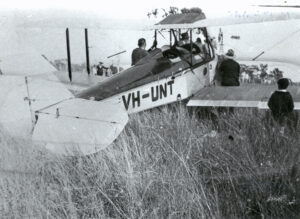
PLANE LOST WHEEL IN RISING
Landed in Patch of Corn- ROSEWOOD, June 3.
After giving joy flights throughout the day, an aeroplane crashed about two miles from Rosewood at 4.25 p.m. yesterday. The plane, which was the property of Mr. T. Appleby, who recently took up residence in Rosewood, was in charge of Pilot Norman Blight, of Brisbane, and arrived here yesterday morning. It lost a wheel when it struck a stump while rising, but the pilot continued and decided to find some soft spot to land. After circling the town he brought the machine down in a patch of corn. After making eight successful joy flights, it was about to ascend for the ninth time with Miss Enid Freeman (Tallegalla), Mr. William Yarrow, jun. (Rosewood), and a child, Dawn Imrie, only daughter of Mr. and Mrs. A. Imrie (Rosewood) as passengers, when portion of the crowd assembled at the Pound Reserve, which the plane was using as a landing ground, moved towards the machine. This caused the pilot to steer a little from his usual track and in so doing one of the wheels of the plane came in contact with a small stump when it was about two feet in the air. The wheel was torn off and the undercarriage broken. The machine, however, kept its balance and continued on its journey. The pilot was signalled and realising his position immediately set in search of a soft landing ground.
TURNED COMPLETELY OVER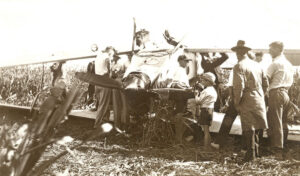
After circling practically the whole of the district for some time he eventually decided on a patch of tall green corn on the property of Mr. Charles Dutney at Ashwell. As the machine came in contact with the ground, the nose dipped, and the propeller was shattered, causing the tail to rise and the machine turned completely over, the passengers being thrown clear. Mr. and Mrs. Dutney were to the scene in time to assist the pilot from the cockpit, and willing neighbours quickly removed the passengers to Mr. Dutney’s residence. In the meantime a large crowd and more than 100 cars had raced out from Rosewood, including Dr. Robert Wallace, who immediately treated Miss Freeman and Mr. Yarrow for slight abrasions. The child appeared to have only suffered from shock. Pilot Blight, however, received more of a jolt and was considerably cut about the face and lips, several stitches being inserted. The machine, which was of the Genairco moth type, was considerably damaged, the propeller being broken in pieces, the undercarriage torn off and the wings and cabin crumpled. The condition of all those who figured in the smash is satisfactory.
It made the headlines Nationally.
Italo-Australian (Sydney, NSW : 1927 – 1940), Saturday 8th June 1935, page 2
IL POLIZIOTTO VOLANTE.
Brisbane, 3 Giugno.
Queensland ha un poliziotto volante, un poliziotto cioè che ha la patente d’aviatore e possiede un apparecchio proprio che e’ da tempo autorizzato ad usare per l’esercizio delle sue funzioni. Costui e’ Constable T. Appleby, di Rosewood. La gatta e’ uscita fuori dal sacco allorché l’apparecchio rimase danneggiato in un atterraggio di fortuna vicino Rosewood la domenica scorsa. Constable Appleby, il quale ha servito per tre anni nell’aviazione militare prima d arruolarsi nella polizia, intende di riparare ed alterare l’apparecchio per renderlo più adatto alla sua bisogna.
————————————————————————————————
Constable Appleby held an Aerial Pageant at Rosewood on Saturday 18th April 1936. Twelve planes took part. Messrs. J. Bodman, J. Liddell, and J. Wright of Rosewood were gatekeepers and aviation officers from Brisbane, Pilots J. B. Hucker, C. G. Henderson, and N. C. P. Blight had control of the pageant.
The events were witnessed by a large crowd, who were thrilled by the daring exploits performed during the afternoon. Joy rides were conducted during the afternoon, and many people took the opportunity to view Rosewood from the air.
The Derby Handicap was won by Pilot Jenyns in a Royal Queensland Aero Club’s Moth. Second was Pilot Parsons, in the club’s new Hornet Moth. Mr. P. Moore, in a privately-owned Moth came third. They offered a fine sight as their engines roared over the town during the progress of the race. The bombing event, results were – Pilot Blight (Moth), 1; Pilot Bashford (Moth), 2; Miss Ivy Pearce (Moth), 3. Captain P. Moody and Chief Instructor D. G. Cameron, late of the R.A.A F., gave displays of aerial acrobatics.
————————————————————————————————
On 13th October 1943, there was an aircraft accident at Lowood Airfield. Read about it here.
————————————————————————————————
Townsville Daily Bulletin, Wednesday 10th October 1945, page 4
MILLIONTH AIR PASSENGER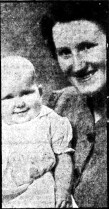
Mrs. M. F. Radcliffe, of Rosewood, via Ipswich, has achieved the distinction of becoming the millionth air passenger carried by Australian National Airways, and, at the same time, the millionth air passenger ever to be carried by any Civil Airline Organisation in the British Empire. This distinction became hers when she travelled by air from Perth to Melbourne recently on her way to Queensland to join her husband, who is in the Armoured Division, A.I.F..
Mrs. Radcliffe is photographed here with her six months old daughter, Ann. The young couple are, at the moment, living with Mr. Radcliffe’s parents at Rosewood, where Mr. Radcliffe (senior) is the local schoolmaster.
To mark this unique and historic event A.N.A. are arranging for Mrs. Radcliffe to be presented with a suitable trophy, and, in addition, she is to be the guest of the company for one week in whatever capital city she cares to select in Australia.
Interviewed, Mrs. Radcliffe was very thrilled with the announcement. She has already decided to take the opportunity to return to her home in Perth to see her sister, married early in the new year. Her sister, a member of the A.W.A.S. has been in New Guinea for the past year. Mrs. Radcliffe’s parents are Mr. and Mrs. T. Garth, Highgate Hill, Perth.
————————————————————————————————
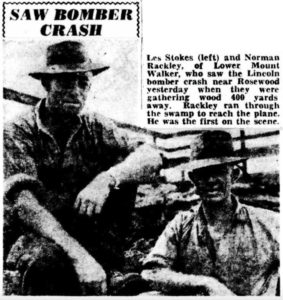 On 7th March 1950, four members of the Royal Australian Air Force, who were on a training flight, were killed instantly when a Lincoln four-engined bomber from Amberley crashed into scrub at Lower Mount Walker.
On 7th March 1950, four members of the Royal Australian Air Force, who were on a training flight, were killed instantly when a Lincoln four-engined bomber from Amberley crashed into scrub at Lower Mount Walker.
The victims were—Flight-Lieutenant Clayton Brennan Lynch, D.F.C. (34), married, of Elizabeth-street, Ipswich; Pilot 2 Leonard Maurice Bradney (24), married, of Darling-street, Ipswich; Navigator 2 Stanley Samuel Templer (35), married, of Norwood, Adelaide; Signaller 1 James Henry Wiber (28), single, Annandale, New South Wales.
See the write ups here and here.
